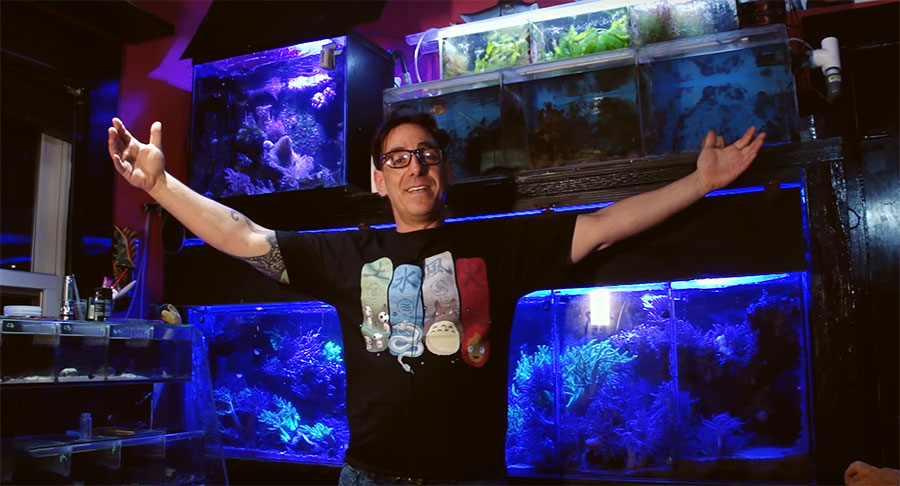
Where the octopus magic happens: Richard Ross invites NPR’s Science Friday into his “Secret Home Lab”…which really isn’t a secret once you broadcast it on a national news program!
You may recognize Richard Ross (aquarist & biologist at the California Academy of Sciences’ Steinhart Aquarium) as a popular aquarium conference speaker and espouser of critical thinking in the reef aquarium hobby. While he may be better known these days for helping aquarists ferret out snake oil or running a successful reef tank despite having questionable phosphate levels, he’s never left his primal love of cephalopods behind. But you know he made it to prime-time when his work was featured in a video from Science Friday, the weekly radio show heard on many public radio stations and NPR!
This Science Friday video brings us into Ross’s California-based, not-so-Secret Home Lab to learn about and witness the reproduction of the Lesser Pacific Striped Octopus, Octopus chierchiae. A native to the intertidal waters on the Pacific coast of Central America, this tiny, attractively zebra-striped Octopus has been called a “most-wanted octopus” among the cephalopod community TONMO.
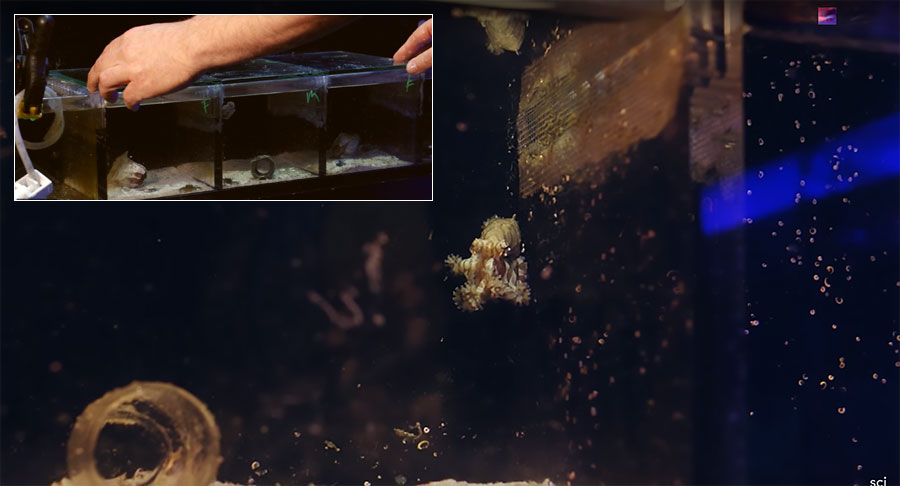
A sense of scale: this small cube in an acrylic rack system looks downright spacious when compared to the mature size of Octopus chierchiae.
Measured by mantel length, this is truly a dwarf species, with females reaching just 1″ (25 mm), and males less. Because they are naturally short-lived, establishing a captive-bred population has been a long-time goal; Ross, along with Dr. Roy Caldwell, first documented attempts to keep and breed this species back in 2010 in the article “Aquarium Invertebrates: Octopus chierchiae – The Lesser Pacific Striped Octopus.” While this earlier attempt ultimately failed, many lessons were learned.
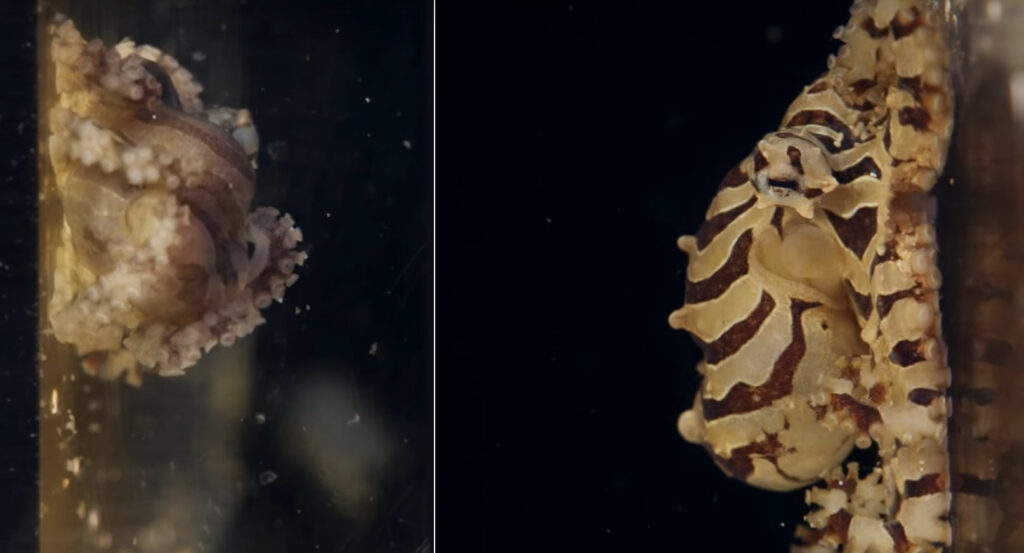
To a prospective breeder’s delight, male (left) and female Octopus chierchiae are incredibly easy to differentiate: the secret is in the tentacles. You’ll have to watch the film to find out how to sex this adorable little octopus.
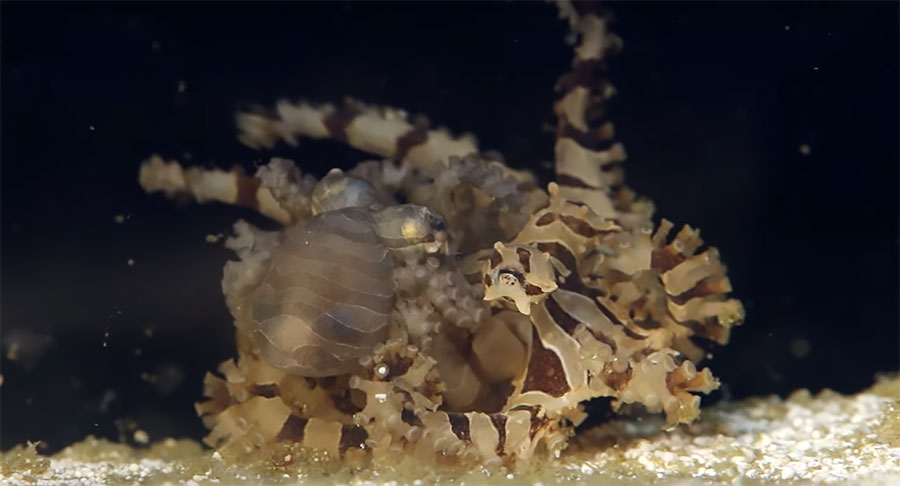
A tangle of tentacles: the mating of the Lesser Pacific Striped Octopus, Octopus chierchiae, caught on film.
CORAL Magazine followed up on the Science Friday video with Ross, and he shared a few key updates.
- After the successful breeding documented in the video, Ross succeeded in producing a second generation of captive-bred O. chierchiae in the Secret Home Lab, officially “closing the life cycle” in captivity, an important aquaculture milestone.
- Ross noted that “it is insanely labor-intensive to raise baby O. chierchiae.” Because of cannibalism concerns, each animal must be housed individually, but this results in a range of husbandry problems centered around water flow, air, and feeding. “I have been trying to make it easier,” continued Ross, who cited his current rearing experiments aimed at communal rearing utilizing small net pens in water baths to minimize the labor during the first month or two of a rearing run.
- Based on his experiences to date, Ross concludes that “O. chierchiae are a perfect animal for lab work—if we can breed and raise them easily.”
- Concerns over the political climate in the region suggest that establishing a viable and self-sustainable captive breeding population of this octopus species is very important, as access to wild-collected specimens may be difficult or impossible in the future.
- Given their size and husbandry requirements, O. chierchiae might make ideal captive-bred cephalopod pets at some point in the future. However, don’t rush out to get your hands on one just yet, because…
- …there is concern that O. chierchiae may be venomous. As Ross puts it, “we have no idea how venomous they are or might be, but their bold black and white stripes seem to be saying, ‘*@$! off’!”
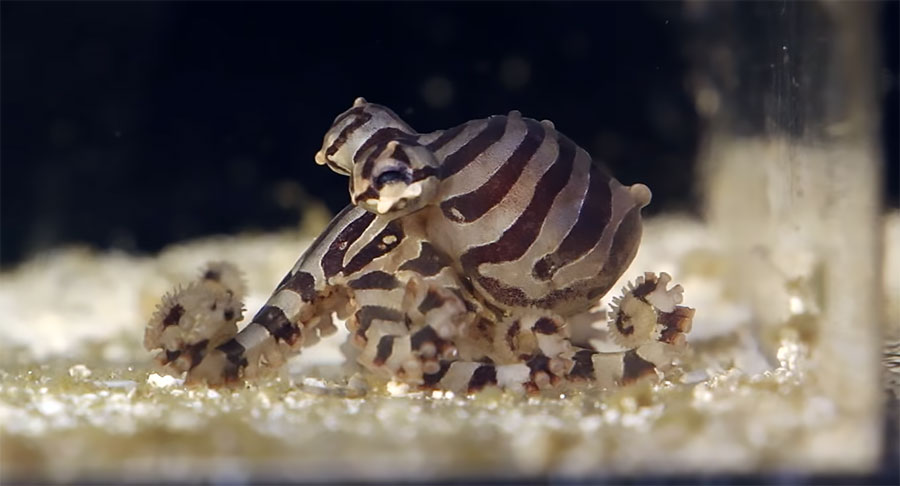
Beautiful, tiny, and possibly available as a captive-bred Octopus in the future, O. chierchiae has a lot to offer the aquarist…including a potentially venomous bite?
Considering the lethal nature of a bite from the Blue-Ringed Octopuses (Hapalochlaena spp.), questions and concerns of the toxicity of the Octopus chierchiae shouldn’t be brushed off. Until the scientific community can answer the question of O. chierchiae‘s possibly toxic nature, we’d suggest that anyone who obtains this species takes appropriate (and extra) precautions when working with it. But that shouldn’t prevent you from dreaming and enjoying this wonderful video look at breeding the Lesser Pacific Striped Octopus in the Secret Home Lab.
Watch the Science Friday episode now:
Image Credits: Video stills from the above by Science Friday





The video of the Octobpus was super and I learned a lot in the short viewing time. My hats off to Richard for his work with these really neat and unusual animals.